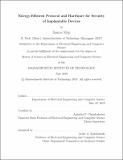| dc.contributor.advisor | Anantha P. Chandrakasan. | en_US |
| dc.contributor.author | Maji, Saurav. | en_US |
| dc.contributor.other | Massachusetts Institute of Technology. Department of Electrical Engineering and Computer Science. | en_US |
| dc.date.accessioned | 2019-11-04T19:54:02Z | |
| dc.date.available | 2019-11-04T19:54:02Z | |
| dc.date.copyright | 2019 | en_US |
| dc.date.issued | 2019 | en_US |
| dc.identifier.uri | https://hdl.handle.net/1721.1/122701 | |
| dc.description | This electronic version was submitted by the student author. The certified thesis is available in the Institute Archives and Special Collections. | en_US |
| dc.description | Thesis: S.M., Massachusetts Institute of Technology, Department of Electrical Engineering and Computer Science, 2019 | en_US |
| dc.description | Cataloged from student-submitted PDF version of thesis. | en_US |
| dc.description | Includes bibliographical references (pages 77-83). | en_US |
| dc.description.abstract | Modern-day bio-electronics has truly revolutionized monitoring, diagnosis, and treatment of disease. The continued development of microelectronic has fueled the development of implantable and wearable devices by enabling them with increased functionality and features. According to the report, global active implantable medical devices (IMDs) market was valued at approximately USD 16.47 billion in 2017 and is expected to generate revenue of around USD 23.33 billion by the end of 2024 [63]. However, the deployment of these devices is limited by their security concerns. Several attacks have been demonstrated on IMDs by exploiting their weaknesses [29, 36, 38, 58, 72]. Although these attacks have been demonstrated for academic investigation, these are enough to confirm that the security of these systems needs to be addressed more aggressively. In this work, we analyze the security concerns in the design of the IMDs and the interactions with the other parties involved. Based on this analysis, we propose a protocol to address some of the shortcomings. Our protocol features a dual-factor authentication system in the IMD that relies on both cryptographic security as well as voluntary human actions before responding to any request. We discuss the merits of the protocol and analyze the trade-offs involved. The proposed protocol is implemented in an energy-efficient integrated circuit-and-system solution to emulate an actual implantable device. The design decisions involved to make the system energy-efficient and to accelerate the cryptographic computation are analyzed in detail. Finally, the impact of the implemented protocol on the entire system is obtained and discussed for various use-cases. | en_US |
| dc.description.sponsorship | "Analog Devices Fellowship and Analog Devices Inc. for providing financial support during various phases of this project" | en_US |
| dc.description.statementofresponsibility | by Saurav Maji. | en_US |
| dc.format.extent | 83 pages | en_US |
| dc.language.iso | eng | en_US |
| dc.publisher | Massachusetts Institute of Technology | en_US |
| dc.rights | MIT theses are protected by copyright. They may be viewed, downloaded, or printed from this source but further reproduction or distribution in any format is prohibited without written permission. | en_US |
| dc.rights.uri | http://dspace.mit.edu/handle/1721.1/7582 | en_US |
| dc.subject | Electrical Engineering and Computer Science. | en_US |
| dc.title | Energy-efficient protocol and hardware for security of implantable devices | en_US |
| dc.type | Thesis | en_US |
| dc.description.degree | S.M. | en_US |
| dc.contributor.department | Massachusetts Institute of Technology. Department of Electrical Engineering and Computer Science | en_US |
| dc.identifier.oclc | 1124925617 | en_US |
| dc.description.collection | S.M. Massachusetts Institute of Technology, Department of Electrical Engineering and Computer Science | en_US |
| dspace.imported | 2019-11-04T19:54:01Z | en_US |
| mit.thesis.degree | Master | en_US |
| mit.thesis.department | EECS | en_US |

